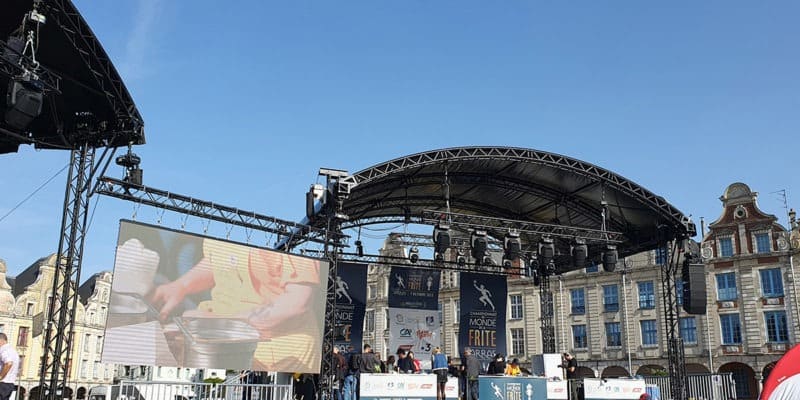On Saturday, October 7, 2023, the town of Arras was transformed into a veritable gastronomic stage as it hosted the first edition of the World French Fry Championship. The Grand’Place d’Arras was the epicenter of this culinary celebration, attracting an audience of 15,000 epicureans and some thirty competitors passionate about the famous delicacy. Here’s a look back at the event.
How the 1st World Frying Championship unfolded
Jury president Jean-Paul Dambrine was particularly delighted with this first-of-its-kind event. He emphasized the extraordinary participation of candidates from as far afield as the South of France. In his view, the success of this competition could do much to promote the profession of fry cooks, and recognize the place of French fries in gastronomic culture. The candidates did not hesitate to show their inventiveness. For example, one of them put forward an idea for a frite paired with Bordeaux ceps, offering a taste experience reminiscent of a walk in the forest, all in the heart of Arras’ Grand’Place. Among the four finalists was Japan’s Eugio Yamagouchi, who plans to open a restaurant in Paris. This competitor works alongside an exceptional assistant, the world champion of pâté en croûte, a competition that celebrates excellence in the shadow of Bocuse. Together, with determination, they have dedicated themselves to their mission to the very end.
But they didn’t win !
Indeed, the competition ended on a high note with the announcement of the winners. Aurèle Mestré, from Lille, won the prestigious title of World Champion French Fryer. His efforts were rewarded, and he expressed his delight at such a large audience. Several other candidates also distinguished themselves in different categories: Philippe Frenoi for the family fry, Allan Gilley Pavard for the best fry sauce, and Clément Krupka for his innovative approach to creative frying. 
French fries: a love affair with the Hauts-de-France region
The true origin of frites is a matter of debate, although many people spontaneously associate them with Belgium. According to some sources, the inhabitants of the Meuse valleys in Belgium began frying small fish in 1680. In winter, when fishing became difficult, they replaced them with potatoes cut in the shape of small fish, giving rise to the first French fries. Other stories suggest that France or even Spain may be the true birthplace of this delicious delicacy.
The ascent in Hauts-de-France
Our region of Hauts-de-France, on the border with Belgium, quickly adopted and adapted the French fry, making it an essential part of its gastronomic culture. In our beautiful region, “baraques à frites” or “friteries” have become landmarks, serving crispy fries, often accompanied by mussels or other local specialties. Local festivals and markets are often enlivened by these stands, where fries are prepared to perfection in large vats of boiling oil.
Innovations and adaptations
Over time, frites have evolved in our region of Hauts-de-France, and while the traditional method of double-cooking to ensure “crisp on the outside and soft on the inside” remains the norm, many variations have emerged. A variety of sauces, specific seasonings and accompaniments have enriched the taste palette of French fries. It has become not only a simple garnish, but also the heart of many regional dishes, as we will see below.

Traditional ketchup fries (we prefer mayo)
The consecration of French fries in Arras, a testimony to our gastronomic heritage
The celebration of the French Fry World Championship in Arras underlines the deep roots of this specialty within the gastronomic culture of the Hauts-de-France region. With a multitude of participants and thousands of visitors in attendance, this event not only highlights the passion for French fries, but also their central place in many regional dishes.
These include :
- Moules-frites (mussels fries) : Arguably the most famous dish associated with French fries, moules-frites is an unmissable classic. Originally from the North of France, this dish combines freshly steamed mussels, usually flavored with white wine, shallots and parsley, with crispy French fries. Served generously, this dish is often accompanied by a local lager ;
- Carbonnade flamande : Carbonnade flamande is a beef stew slowly simmered in a beer and onion sauce.
Rich in flavor, it is traditionally served with French fries, which soak up the dish’s sweet and sour sauce ; - Welsh : Imported from Wales, Welsh has become a staple in Northern France. It’s a hearty dish of melted cheddar, beer and mustard, served on a slice of bread and often accompanied by ham. French fries, served on the side, add a crunchy touch to this melt-in-the-mouth preparation ;
- Chicory au gratin : Also known as endives au jambon, this dish combines the light bitterness of braised endives wrapped in ham, topped with a béchamel sauce au gratin. Although traditionally served with potatoes, many restaurants and homes in the North of France like to serve it with French fries for a more gourmet touch ;
- The traditional steak and French fries: A simple but effective classic. Juicy steak grilled to perfection is paired with crispy fries to create a timeless duo that satisfies even the most voracious appetites ;
- L’andouillette d’Arras: An emblematic delicatessen speciality of today’s Hauts-de-France region, and celebrated every year. Made from selected parts of the pig’s large intestine and stomach, andouillette is distinguished by its pronounced taste and unique texture. In Arras, this charcuterie is prepared using traditional methods, giving it an authentic flavor. Usually grilled or pan-fried, it is served hot, with mustard or a white wine sauce. Although its strong flavor can be divisive, it is adored by many charcuterie lovers. To complete this regional dish, there’s nothing better than a portion of crispy, golden French fries and a glass of local beer or white wine to balance the palate.
French fries, with their crispy exterior and soft interior, complement and enhance these dishes, adding a unique texture and flavor. It’s more than just a garnish: it’s an integral part of the Hauts-de-France gastronomic experience, and its role in the region’s culinary identity cannot be underestimated.
R.C.
